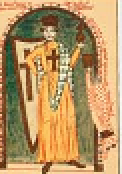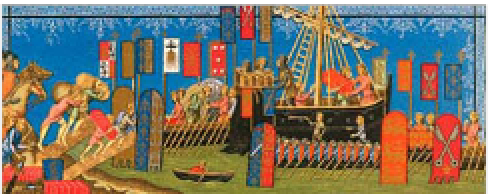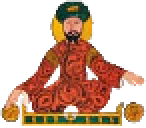Travel Reference
In-Depth Information
The Crusades
“God wills it!” With these words, on
27 November 1095 at the Council
of Clermont, Pope Urban II launched an
appeal to aid the Byzantines in their wars
with the Seljuk Turks and so free the Holy
Land. His preachings inspired more than
100,000 men and women from all over
Europe to join the armies heading east.
They succeeded in creating a Latin king-
dom of Jerusalem, but a series of further
Crusades meant to reinforce the Western
Christian presence in the east were ever less successful.
Within 200 years the Crusaders were gone, leaving a
legacy of fine ecclesiastical and military architecture.
ACRE
•
J
JERUS
A
LEM
Crusading
emperor
Frederick I
THE HOLY L A N D
Crusader domains 1186
C
Church of the
Holy Sepulchre
Scenes from
the life of
Christ
The First Crusade
Passing through Constantinople, the Crusaders
first engaged the Muslim Seljuks in Anatolia
(Turkey). They conquered Nicaea and Antioch
before marching down through Syria to Palestine.
Stylized Gothic
gates of Jerusalem
THE CAPTURE
OF JERUSALEM
On 7 June 1099, the
Crusaders laid siege
to Jerusalem. The
Muslims held out for
five weeks until on
15 July the Christian
troops breached the
walls unleashing a
massive slaughter
in the streets.
The Second Crusade
Most of the Second Crusaders
never made it to the HolyLand.
Those that did launched a
disastrous attack on Damascus
and had to withdraw.
TIMELINE
1119
Founding
of the Knights
Templar
1148
Second
Crusade defeated
while besieging
Damascus
1187
Saladin defeats
the Crusaders at the
Horns of Hattin and
takes Jerusalem
Templar
Knight
1100
1120
1140
1160
1180
1200
1099
Crusaders
capture Jerusalem;
Godfrey of Bouillon
becomes “Protector of
the Holy Sepulchre”
1188-92
Third
Crusade; after
reconquering
much of the coast,
Richard I fails to
retake Jerusalem
Saladin, founder
of the Ayyubid
dynasty
(1169-1250)








































































